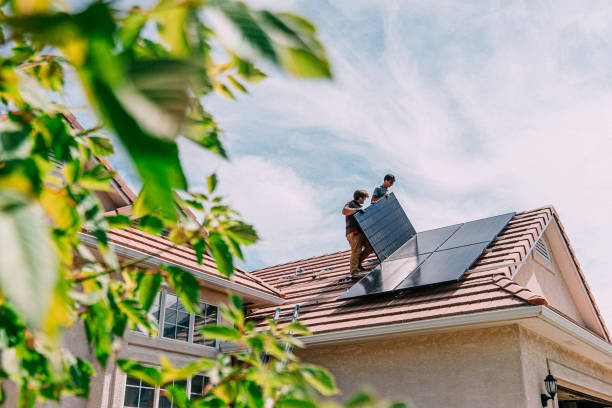Ignoring Dirty Solar Panels Could Be Costing You More Than You Think
Solar panels may look fine on the roof, but dirt buildup, bird droppings, and debris can quietly reduce their power output. Over time, that means less energy — and higher bills. This article explains how unclean panels lose efficiency, what maintenance experts recommend, and how often cleaning actually makes a difference.

When solar panels are installed, most homeowners expect them to operate efficiently with minimal intervention. While solar technology is designed to be low-maintenance, environmental factors continuously affect performance. Dust storms, pollen, leaves, bird droppings, and industrial pollutants gradually accumulate on panel surfaces, creating barriers that prevent sunlight from reaching photovoltaic cells. This buildup may seem insignificant at first, but over time, it translates into measurable efficiency losses and increased operational costs.
Solar Panel Efficiency Loss From Dirt and Dust
Dirt and dust are among the most common culprits behind reduced solar panel efficiency. Studies have shown that dirty panels can experience efficiency losses ranging from 15% to 25%, depending on environmental conditions and the duration since the last cleaning. In arid regions with frequent dust storms or areas with high pollution levels, losses can be even more significant. Even a thin layer of dust can scatter and absorb sunlight before it reaches the photovoltaic cells, directly reducing electricity generation. For a typical residential system producing 10,000 kilowatt-hours annually, a 20% efficiency loss translates to 2,000 kilowatt-hours of lost production. At average electricity rates of 15 cents per kilowatt-hour, this represents approximately $300 in lost savings each year. Over the 25-year lifespan of a solar system, neglecting cleaning could cost thousands of dollars in foregone energy production.
Bird Droppings Damage Solar Panels and Block Sunlight
Bird droppings present a more severe problem than general dust accumulation. Unlike fine particles that spread evenly across panel surfaces, bird droppings create concentrated blockages that can completely obstruct individual cells. Solar panels are wired in series, meaning that when one cell is blocked, it can reduce the output of an entire string of cells. This phenomenon, known as the Christmas light effect, causes disproportionate performance losses. Beyond blocking sunlight, bird droppings contain acidic compounds that can etch and corrode protective glass coatings over time. If left unaddressed, these corrosive substances can create permanent damage, leading to hot spots where cells overheat due to uneven energy distribution. Hot spots not only reduce efficiency but can also cause irreversible damage to photovoltaic cells, potentially requiring costly panel replacements. Regular removal of bird droppings is essential to prevent both immediate performance losses and long-term structural damage.
How Buildup and Debris Increase Long-Term Maintenance Costs
Accumulated debris extends beyond dirt and bird droppings to include leaves, pollen, lichen, and even airborne pollutants. When organic materials like leaves and pollen remain on panels for extended periods, they can foster microbial growth, creating stubborn stains that are difficult to remove. In humid climates, algae and lichen can establish themselves on panel surfaces, further obstructing sunlight and requiring specialized cleaning solutions. Neglecting regular cleaning forces more intensive and expensive maintenance interventions later. What could have been addressed with routine washing may eventually require professional cleaning services, specialized equipment, or even panel repairs. Additionally, warranty coverage from manufacturers often stipulates proper maintenance, including regular cleaning. Failing to maintain panels according to manufacturer guidelines could void warranties, leaving homeowners responsible for repair or replacement costs that would otherwise be covered. The financial impact of deferred maintenance compounds over time, making proactive cleaning a cost-effective strategy.
Solar Panel Lifespan Reduced by Lack of Regular Cleaning
Solar panels are engineered to last 25 to 30 years, but their longevity depends significantly on proper care. Chronic exposure to corrosive substances, moisture trapped under debris, and thermal stress from hot spots can accelerate degradation. When contaminants remain on panel surfaces, they can compromise the integrity of protective coatings and seals, allowing moisture to penetrate and damage internal components. Moisture infiltration can lead to delamination, where layers of the panel separate, and corrosion of electrical connections, both of which are irreversible and require panel replacement. Furthermore, consistent underperformance due to dirt buildup forces inverters and other system components to work harder to compensate, potentially shortening their operational lifespan as well. By maintaining clean panels, homeowners protect not only the panels themselves but also the entire solar energy system, ensuring it reaches or exceeds its expected lifespan and continues delivering maximum returns on investment.
Professional Solar Cleaning Improves Performance and Prevents Costly Damage
While some homeowners attempt DIY cleaning, professional services offer distinct advantages in safety, effectiveness, and damage prevention. Professionals use purified water systems, soft brushes, and appropriate cleaning agents that remove contaminants without scratching or damaging panel surfaces. They also possess the training and equipment necessary to safely access rooftop installations, reducing the risk of accidents. Professional cleaning typically costs between $150 and $300 per session for residential systems, depending on system size and location. Most experts recommend cleaning panels at least twice annually, though frequency should increase in dusty, high-pollen, or bird-heavy environments. Investing in professional cleaning services ensures thorough contaminant removal, early detection of potential issues like cracks or wiring problems, and optimal energy production. The cost of regular cleaning is minimal compared to the potential losses from reduced efficiency and premature system failure.
| Service Provider | Services Offered | Cost Estimation |
|---|---|---|
| Local Solar Maintenance Companies | Inspection, cleaning, minor repairs | $150 - $300 per visit |
| National Solar Service Providers | Scheduled maintenance plans, warranty support | $200 - $400 annually |
| General Cleaning Services with Solar Expertise | Exterior cleaning including solar panels | $100 - $250 per session |
| DIY Cleaning Supplies | Brushes, purified water systems, cleaning solutions | $50 - $150 one-time cost |
Prices, rates, or cost estimates mentioned in this article are based on the latest available information but may change over time. Independent research is advised before making financial decisions.
Maximizing Solar Investment Through Consistent Care
Solar energy systems represent a substantial financial commitment with the promise of long-term savings and environmental benefits. However, realizing these benefits requires consistent attention to maintenance, particularly cleaning. The financial losses from efficiency reductions, combined with the risk of permanent damage and shortened lifespan, make regular cleaning an essential aspect of solar ownership. Homeowners should establish a cleaning schedule appropriate to their local environment, monitor system performance for signs of reduced output, and engage professional services when necessary. By prioritizing panel cleanliness, homeowners protect their investment, maximize energy production, and ensure their solar systems deliver optimal performance throughout their operational life. Neglecting this simple maintenance task can result in thousands of dollars in lost savings and avoidable repair costs, making proactive care a financially sound decision.




